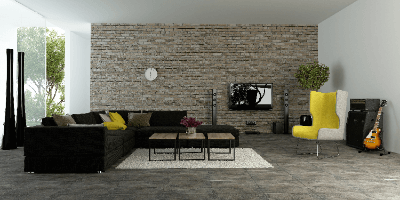What Is an Accent Wall?

An accent wall is a wall that significantly alters the ambiance of a room with other walls in basic colors.
For a room, even a simple change in the pattern or color of the wall can have a large impact on the impression and atmosphere of the space, making it one of the most effective remodeling methods, especially when the room layout is unique to the resident.
The construction of an accent wall itself is relatively inexpensive and simple, such as repainting walls or replacing wallpaper, making it an easy challenge.
Uses for Accent Walls
Generally, walls in most rooms tend to be a single basic color, such as beige or white.
While this may make the room look cohesive and calm, it often lacks interest and does not make the room that much more attractive.
By adding “accent walls” to monochromatic walls, we can create a “focal point,” a point that immediately catches the attention of anyone who enters the room.
To easily create a stylish and glamorous space in a room, lighting, furniture, and accessories can be placed around this focal point, the accent walls.
Principle of Accent Walls
The greatest effect that can be obtained is the ability of accent walls to transform a space in a room and make it stylish all at once.
A room space with only expansive colors such as beige and white certainly has the advantage of feeling expansive.
On the other hand, however, it tends to lack a sense of tension and crispness, creating a sloppy atmosphere.
Adding accent walls to such a room can create a sense of tension and liveliness in the room space by making the walls of the room different from their surroundings.
If the presence of the wall can be increased, items such as furniture and accessories around the wall will stand out as if they are brought to the foreground, creating a three-dimensional effect in the visual field with the accent walls as the centerpiece.
Accent walls also have the effect of serving as a “focal point” that draws the eyes of people entering a room.
Therefore, it is also easy to compose a stylish and easy layout of lighting, furniture, accessories, etc., centered on the wall.
Popular materials for accent walls include stone, tile, brick, and wood.
Stone, tile, and brick can give a space a European look, and they work very well with modern lighting, furniture, and accessories to add accents to a space while maintaining an open atmosphere.
On the other hand, wood accent walls have the advantage of creating a warm and inviting space in a room, bringing a relaxed atmosphere to the occupants.
Some materials not only look good, but also absorb moisture and sound, so when introduced with such materials, accent walls can be effective not only in terms of good-looking design but also in terms of bringing excellent functionality to the room.
In addition to changing the material, changing the color of an existing wall is also a feature of accent walls, and the impression that a room gives to people can be quite different depending on the color.
When choosing a color, the balance of colors is of paramount importance.
First choose the base color, such as beige or white, which occupies most of the walls and ceiling of the room. Next, select the sub-color, which determines the impression of the room by the color of the accent walls. Last is the accent color, which is used for a single point of interest.
Furthermore, it is important to consider the compatibility with lighting, furniture, accessories, etc., and decide on colors while thinking about the total image of the room.